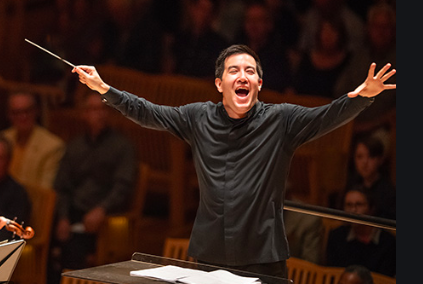|
Symphony
MONUMENTAL MAHLER 5TH IN SO CO PHIL'S SEASON ENDING CONCERT
by Terry McNeill
Sunday, April 14, 2024
Chamber
OAKMONT SEASON CLOSES WITH STRAUSS' PASSIONATE SONATA
by Terry McNeill
Thursday, April 11, 2024
Chamber
MORE GOLD THAN KORN AT ALEXANDER SQ CONCERT
by Terry McNeill
Sunday, April 7, 2024
Choral and Vocal
VIBRANT GOOD FRIDAY REQUIEM AT CHURCH OF THE ROSES
by Pamela Hicks Gailey
Friday, March 29, 2024
TWO OLD, TWO NEW AT THE SR SYMPHONY'S MARCH CONCERT IN WEILL
by Peter Lert
Saturday, March 23, 2024
Chamber
NOT A SEVENTH BUT A FIRST AT SPRING LAKE VILLAGE CONCERT
by Terry McNeill
Wednesday, March 20, 2024
THIRTY-THREE PLUS VARIATIONS AND AN OCEAN VIEW
by Terry McNeill
Saturday, March 16, 2024
Choral and Vocal
A ST. JOHN PASSION FOR THE AGES
by Abby Wasserman
Friday, March 8, 2024
Choral and Vocal
SPLENDID SCHUBERT SONGS IN SANET ALLEN RECITAL
by Terry McNeill
Saturday, March 2, 2024
Chamber
SHAW'S MICROFICTIONS HIGHLIGHTS MIRO QUARTET'S SEBASTOPOL CONCERT
by Peter Lert
Friday, March 1, 2024
|
 |
 Conductor Francesco Lecce-Chong |
A HEALTHY MIX OF TRANSCRIPTIONS AND ORIGINALS FROM THE SR SYMPHONY
by Steve Osborn
Sunday, January 24, 2021
Transcriptions and ascending arpeggios were the order of the day on Jan. 24, as the Santa Rosa Symphony performed uplifting works by Bach/Webern, Ellen Taaffe Zwilich, Marianna Martínes and Mozart. The concert video was made in Weill Hall on Jan. 9.
The first transcription was Webern’s 1935 rendering of Bach’s “Ricercare a 6” from The Musical Offering. At that time, the dominant Bach transcriber was Leopold Stokowski, whose lush and heavily orchestrated transcriptions transformed Bach from a cerebral Baroque composer into an unabashed Romanticist. Webern’s approach is almost the complete opposite. His orchestration is spare, and his method is reverent. The net result in both cases, however, is the same: you’re definitely not listening to Bach.
Webern’s main transcribing device is to divide Bach’s fluid lines among several instruments. A melody that starts in the flutes, for example, migrates to the oboes and thence to the strings, each one playing only a few notes. While the Symphony’s playing was uniformly excellent, one wished for a smaller ensemble a 6 where each player could have a full say.
Zwilich’s Concerto Grosso for Chamber Orchestra (1985) continued the transcription motif, albeit in a more indirect way. The five-movement piece is based on the opening theme from a Handel violin sonata, complete with harpsichord. Both the first and last movements quote the Handel theme directly, interpolating it with sections written by Zwilich. The inner three movements are pure Zwilich, although Handel lurks in the background.
Zwilich’s interpolations in the outer movements consist primarily of ascending Coplandesque arpeggios that stand in stark contrast to Handel’s flowing lines. It’s hard at first to discern a connection between the two, but Zwilich sticks with the alternating pattern until the harmonic, rhythmic and harmonic connections become evident.
The inner movements -- a Largo surrounded by two Prestos -- have the same clearly delineated structure as the outer ones, with continuing use of ascending arpeggios. The dramatic melody of the Largo was particularly well played, with the musicians really leaning into the tragic lines. The only complaint one could make is that the harpsichord was difficult to hear.
Next up was a rarely played Sinfonia by Marianna Martines, a contemporary of Mozart’s in Vienna. According to the program notes, the Sinfonia is the only known symphony of the Classical period (1750-1820) composed by a woman. While that distinction accords the Sinfonia a certain level of interest, the work can also stand on its own merits. The orchestration is inventive, and the spritely ascending arpeggios imbue it with joyfulness. The lilting final movement is a standout. Conductor Francesco Lecce-Chong heightened its effect by giving strong downbeats and eliciting firm dynamic contrasts. The echo effects were excellent, as was the hard-charging tempo.
Mozart’s 39th symphony is played so often by so many orchestras that it’s hard to hear anew; but the virtual concert format, coupled with Mr. Lecce-Chong’s sensitivity and expertise, did offer a new way of listening to this masterpiece. To begin with, the reduced forces onstage helped bring out the individual lines, and the sound achieved a limpid quality usually found in string quartets.
Beyond that, Mr. Lecce-Chong’s conducting was magnificent. Using spare motions, he coaxed Mozart’s serene Allegro melody out of the opening Adagio. The first violins sounded like opera singers as they floated above the orchestral underlay throughout the first movement. In the Andante second movement, the inescapable ascending arpeggios set up a fervent response to Mozart’s elegant theme. Mr. Lecce-Chong gave strong beats, but it was his motions between beats that allowed the musicians to bend the notes and flex the rhythm.
The third movement was greeted with a cough from the stage, an apt reminder of the live concert experience. Here the strings put their bowing techniques on display, alternating between a light spiccato and an expressive legato. The clarinet duet by Roy Zajac and Mark Wardlaw was likewise superb.
The finale was stirring. The violins led off with a pitch-perfect blur of notes, with each run clearly articulated. The conductor bent his knees in time with the music, moving everyone hastily along, even as the top lines played melodies of exquisite delicacy. It was hard to imagine so much serenity atop a hurtling object, but everyone landed safely on the resounding final chords.
|

